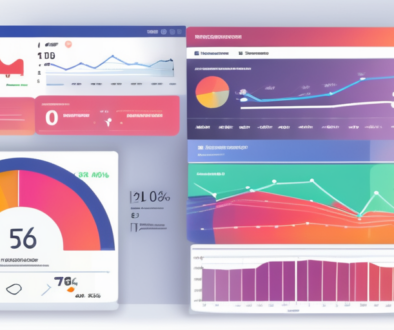How to Use Google Ads to Boost Your E-Commerce Store
In today’s digital world, having a strong online presence is crucial for the success of any e-commerce business. One effective way to achieve this is by utilizing Google Ads. Google Ads is a powerful advertising platform that allows businesses to reach their target audience and drive profitable traffic to their website. In this article, we will explore the top ideas for leveraging Google Ads to achieve e-commerce success.
Understanding the Importance of Google Ads in E-Commerce
Before diving into the specifics, it’s important to understand the role that Google Ads plays in the growth of an online business. Google Ads is Google’s online advertising program that enables businesses to create and display ads on the Google search engine results page. With millions of people using Google to search for products and services every day, Google Ads provides businesses with an opportunity to capture the attention of potential customers at the right time and in the right context.
The Role of Google Ads in Online Business Growth
Google Ads can be a game-changer for e-commerce businesses. By using this platform effectively, businesses can increase their brand visibility, generate quality leads, drive website traffic, and ultimately boost sales. Google Ads allows businesses to target specific keywords related to their products or services, ensuring that their ads are shown to users who are actively searching for what they offer. This highly targeted approach maximizes the chances of converting prospects into customers.
How Google Ads Drive E-Commerce Success
Google Ads offers various features and tools that can contribute to the success of an e-commerce business:
- Remarketing: By utilizing the power of remarketing, businesses can show ads to users who have previously visited their website but didn’t make a purchase. This strategy helps to keep the brand top of mind and increases the chances of conversion.
- Product Listing Ads: E-commerce businesses can take advantage of Google’s product listing ads to showcase their products directly on the search engine results page. These visually appealing ads display product images, descriptions, and prices, making it easy for users to make purchase decisions.
- Local Inventory Ads: For businesses with physical stores, local inventory ads can be a great way to drive foot traffic. These ads display product availability at nearby locations, encouraging users to visit the store and make a purchase.
In addition to these features, Google Ads also provides businesses with detailed analytics and reporting tools. This allows businesses to track the performance of their ads, measure the return on investment, and make data-driven decisions to optimize their campaigns. The ability to monitor and analyze the effectiveness of their advertising efforts is crucial for e-commerce businesses to stay competitive in the online marketplace.
Furthermore, Google Ads offers a variety of ad formats beyond the traditional text ads. Businesses can leverage responsive search ads, which automatically adjust their size, appearance, and format to fit the available ad space. This flexibility ensures that ads are displayed correctly across different devices and screen sizes, providing a seamless user experience.
Another important aspect of Google Ads is its integration with other Google tools and platforms. For example, businesses can connect their Google Ads account with Google Analytics to gain deeper insights into user behavior and website performance. This integration enables businesses to refine their targeting strategies, optimize their landing pages, and improve the overall user experience.
In conclusion, Google Ads plays a vital role in the success of e-commerce businesses. By utilizing its features and tools effectively, businesses can increase their brand visibility, drive targeted traffic, and ultimately boost sales. The ability to reach potential customers at the right time and in the right context is what sets Google Ads apart and makes it an essential component of any e-commerce marketing strategy.
Key Google Ads Strategies for E-Commerce
Now that we understand the importance of Google Ads in e-commerce, let’s explore some key strategies that can help businesses make the most out of their advertising campaigns.
One strategy that can greatly enhance the effectiveness of your Google Ads campaign is utilizing keyword research. Keyword research is the foundation of any successful campaign, as it allows you to identify the right keywords that are relevant to your products or services. By targeting these keywords, you can ensure that your ads are shown to users who are actively searching for what you offer. To conduct keyword research, you can make use of various tools available online that provide insights into high-volume and relevant keywords. Incorporating these keywords into your ad campaigns will increase the visibility of your ads and drive more qualified traffic to your e-commerce website.
In addition to targeting the right keywords, crafting compelling ad copy is equally crucial in capturing the attention of your target audience. Your ad copy should not only be informative but also persuasive. It should highlight the unique selling points of your products, offer clear benefits to potential customers, and include a strong call to action. A well-crafted ad copy can significantly increase the click-through rate and drive more traffic to your e-commerce website. Remember, the goal is to entice users to click on your ads and take action, whether it’s making a purchase or signing up for a newsletter.
Another strategy that can improve the performance of your Google Ads campaigns is leveraging ad extensions. Ad extensions are additional pieces of information that can be added to your ads to make them more visible and informative. They provide users with more reasons to click on your ads and can improve the overall performance of your campaigns. For e-commerce businesses, some popular ad extensions include sitelink extensions, callout extensions, and structured snippet extensions. Sitelink extensions allow you to add additional links to specific pages on your website, giving users more options to explore. Callout extensions enable you to highlight specific offers, promotions, or unique selling points. Structured snippet extensions allow you to showcase specific aspects of your products or services, such as different models, brands, or categories. By leveraging these ad extensions, you can enhance the visibility and relevance of your ads, ultimately driving more conversions for your e-commerce business.
Optimizing Google Ads for E-Commerce
In addition to implementing effective ad strategies, optimizing your Google Ads campaigns is crucial for e-commerce success.
When delving into the world of Google Ads for e-commerce, it’s essential to understand that the landscape is constantly evolving. Staying ahead of the curve means continuously refining your strategies and keeping up with the latest trends and updates from Google. By staying informed and adapting to changes swiftly, you can ensure that your ads remain relevant and effective in reaching your target audience.
Importance of Landing Page Optimization
A well-optimized landing page can significantly increase the chances of converting ad clicks into sales. Ensure that your landing page is relevant to the ad and provides users with a seamless experience. Optimize the page for speed, usability, and mobile responsiveness to maximize conversions.
Furthermore, incorporating compelling visuals, clear call-to-actions, and persuasive copywriting on your landing page can further enhance the user experience and encourage visitors to take the desired action. Remember, the landing page serves as the bridge between your ad and the conversion, so investing time and resources into its optimization can yield substantial returns.
The Role of Quality Score in Ad Performance
Google assigns a quality score to each of your keywords, which affects the cost and position of your ads. Improving your quality score requires optimizing your keywords, ad relevance, and landing page experience. By optimizing your campaigns for a higher quality score, you can improve the overall performance of your Google Ads campaigns.
Moreover, conducting A/B testing on your ad copy, testing different bidding strategies, and refining your targeting parameters are all strategies that can positively impact your quality score. By continuously monitoring and tweaking these elements, you can strive for a higher quality score, leading to better ad performance and cost-efficiency.
Implementing Conversion Tracking for Better ROI
Conversion tracking allows you to measure the success of your Google Ads campaigns by tracking the actions that users take on your website, such as making a purchase or filling out a form. By implementing conversion tracking, you can identify which campaigns, keywords, or ads are driving the most conversions and optimize your advertising efforts accordingly.
Furthermore, delving deeper into the data provided by conversion tracking can unveil valuable insights into user behavior and preferences. This data can then be leveraged to refine your targeting, messaging, and overall campaign strategy, ultimately leading to a higher return on investment and more effective ad campaigns.
Budgeting and Bidding Strategies for Google Ads
Managing your budget effectively and utilizing the right bidding strategies is crucial for maximizing your return on investment (ROI) with Google Ads.
When it comes to Google Ads, budgeting and bidding strategies go hand in hand. It’s not just about how much you spend, but also about how you spend it. By understanding the nuances of bidding strategies and budget management, you can ensure that every penny you invest in Google Ads works towards achieving your business goals.
Understanding Google Ads Bidding Strategies
Google Ads provides various bidding strategies to help businesses achieve their advertising goals. Whether you choose manual bidding, automated bidding, or a combination of both, it’s important to understand the different strategies and select the one that aligns with your objectives and budget.
Manual bidding gives you full control over how much you’re willing to pay for clicks, while automated bidding lets Google’s algorithms adjust your bids to maximize results. Choosing the right strategy depends on factors like your advertising goals, budget, and level of expertise in managing Google Ads campaigns.
Effective Budget Management for Google Ads
Setting a realistic budget and managing it effectively is essential for e-commerce success with Google Ads. Continuously monitor the performance of your campaigns and allocate your budget based on the campaigns that are driving the highest ROI. Regularly analyze your performance data and make adjustments to optimize your budget allocation.
Effective budget management also involves understanding the seasonality of your business and adjusting your budget accordingly. For example, during peak seasons or promotional periods, you may need to increase your budget to capture higher demand and maximize sales. On the other hand, during slower periods, you can reallocate your budget to focus on branding or awareness campaigns to maintain visibility without overspending.
Measuring and Analyzing Google Ads Performance
Tracking and analyzing the performance of your Google Ads campaigns is crucial for making data-driven decisions and optimizing your advertising efforts.
When it comes to measuring the success of your Google Ads campaigns, it’s essential to delve into the key metrics that provide valuable insights into their performance. One such metric is the click-through rate (CTR), which indicates the percentage of people who clicked on your ad after seeing it. A high CTR typically signifies that your ad is relevant and engaging to your target audience.
Another important metric to track is the conversion rate, which measures the percentage of users who completed a desired action, such as making a purchase or filling out a form, after clicking on your ad. Understanding your conversion rate can help you assess the effectiveness of your ad in driving valuable actions from users.
Key Google Ads Metrics to Track
Some key metrics to track include click-through rate (CTR), conversion rate, cost per conversion (CPA), and return on ad spend (ROAS). By monitoring these metrics over time, you can identify trends, spot areas for improvement, and make data-driven decisions to optimize your campaigns.
Cost per conversion (CPA) is another critical metric that measures the average amount you spend on advertising to acquire a single conversion. By keeping a close eye on your CPA, you can ensure that your advertising costs align with your budget and goals, ultimately maximizing the efficiency of your campaigns.
Return on ad spend (ROAS) is a metric that calculates the revenue generated for every dollar spent on advertising. A high ROAS indicates that your ads are driving significant revenue relative to your ad spend, highlighting the profitability of your campaigns.
Using Google Analytics for In-depth Ads Analysis
Google Analytics is a powerful tool that provides in-depth insights into the performance of your Google Ads campaigns. By integrating Google Analytics with your Google Ads account, you can gain valuable information about user behavior, website conversions, and the overall impact of your advertising efforts. Use this data to identify areas for improvement and fine-tune your Google Ads strategies.
Furthermore, Google Analytics offers advanced features such as audience segmentation, which allows you to analyze the behavior of specific user groups and tailor your ads to their preferences. By leveraging these insights, you can create more targeted and personalized campaigns that resonate with your audience.
In conclusion, Google Ads is an invaluable tool for driving e-commerce success. By understanding the importance of Google Ads, utilizing effective ad strategies, optimizing your campaigns, and measuring performance, you can maximize your return on investment and achieve your e-commerce goals. Start implementing these top Google Ads ideas for e-commerce success today!



